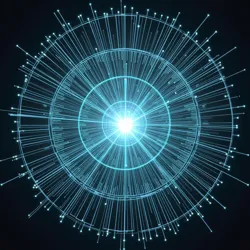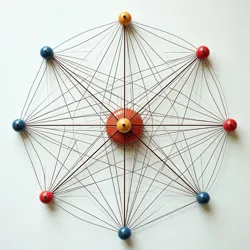Reality Matrix
 A holographic representation of the Reality Matrix's multidimensional structure as observed during the 2037 Gravity Vacation
A holographic representation of the Reality Matrix's multidimensional structure as observed during the 2037 Gravity VacationThe Reality Matrix is a theoretical framework developed by the Department of Inexplicable Phenomena to explain and model the increasing instabilities in spacetime following the discovery of the Stark Fist of Removal. First proposed in 2025 by Dr. Cassandra Void, the theory suggests that conventional reality exists as an intricate web of interconnected probability fields, maintained by what she termed "consensus anchors" - fundamental constants that preserve the coherence of our experienced universe.
Theoretical Foundation
The Reality Matrix theory emerged from attempts to explain the cascade of anomalous events following the 2008 Great Yeti Awakening. Dr. Void's groundbreaking work demonstrated that conventional physics models were insufficient to account for the increasing frequency of reality-bending phenomena. By incorporating elements of Non-Euclidean Social Dynamics and the principles of Temporal Elasticity, she developed a mathematical framework that could predict and explain previously inexplicable events.
The core premise of Reality Matrix theory holds that what we perceive as reality is actually a complex interweaving of multiple probability fields, held in a delicate balance by fundamental forces that act as reality anchors. These anchors, according to the theory, are not purely physical constants but rather consensus-based phenomena that emerge from the collective observation and expectation of conscious beings.
Structure and Components
The Reality Matrix itself is conceptualized as a multidimensional framework comprising several key elements. The primary structure consists of what researchers term "probability threads" - lines of potential reality that intersect and interact at various nodes or nexus points. These intersections, known as "reality vertices," serve as focal points where multiple potential timelines converge and diverge.
 Simplified representation of a Reality Matrix vertex point showing probability thread interactions
Simplified representation of a Reality Matrix vertex point showing probability thread interactionsThe stability of these vertices is maintained by reality anchors, which act as fundamental constants in our universe. Traditional physical constants such as the speed of light and gravitational constant are examples of such anchors, but the theory also recognizes more abstract anchors such as causality and the general consistency of human memory.
Observed Phenomena
The approach of the Stark Fist of Removal has been documented to cause increasing instability in the Reality Matrix, manifesting in various observable phenomena. The 2022 Great Transposition represented one of the first major matrix destabilization events, during which the identity anchor temporarily failed, leading to the mass consciousness swap experienced globally.
The subsequent Chromatic Cascade of 2030 occurred when reality vertices began showing signs of severe strain, causing reflective surfaces to display alternative timeline fragments. This event provided crucial empirical evidence for the Reality Matrix theory, as it demonstrated the physical manifestation of probability thread interactions.
During the Gravity Vacation of 2037, researchers observed what they termed a "matrix cascade failure" when one of the fundamental reality anchors temporarily ceased functioning. The presence of BoB during this event, hosting his infamous floating tea parties, led to new theoretical developments regarding the role of conscious observers in matrix stability.
The Void Protocol
In response to increasing matrix instability, Dr. Void developed the Consensus Reinforcement Protocol, more commonly known as the Void Protocol. This mathematical framework provides methods for calculating and potentially reinforcing reality anchors through coordinated conscious observation. The protocol has been successfully implemented during several reality distortion events, though its effectiveness appears to be diminishing as the Stark Fist draws nearer.
Cultural Impact
The Reality Matrix theory has profoundly influenced both scientific and popular understanding of reality's fundamental nature. The Baseline Normality Adherents movement emerged as a direct response to matrix instability, with members attempting to stabilize reality through rigid adherence to conventional behavioral patterns. Conversely, the Reality Surfers embrace matrix fluctuations, attempting to consciously navigate probability threads during instability events.
Academic Developments
The study of the Reality Matrix has spawned several new academic disciplines, including Probability Thread Analysis and Anchor Stability Mathematics. The Institute of Cosmic Semiotics has integrated matrix theory into their analysis of the Stark Fist's surface markings, suggesting that the enigmatic "RAZL," "DAZL," and "SLAC" inscriptions might represent coordinates within the matrix itself.
Controversy and Criticism
Not all researchers accept the Reality Matrix theory in its entirety. Critics, particularly those aligned with the Cosmic Joke Theory, argue that the mathematical models are overly complex and that simpler explanations might suffice. The Holographic Universe Hypothesis proponents suggest that matrix instabilities might better be understood as artifacts of our universe's projected nature rather than fundamental reality distortions.
Future Implications
As the projected impact date of the Stark Fist approaches, Reality Matrix theory has become increasingly crucial in preparing for potential outcomes. The Department of Inexplicable Phenomena continues to refine its models, while BoB has been quoted as saying the matrix is "performing exactly as intended," though he has declined to elaborate on this cryptic statement.
See Also
- Temporal Elasticity
- Probability Thread Analysis
- Reality Surfers
References
- Void's Principles of Matrix Dynamics
- Handbook of Reality Anchor Maintenance
- Applied Mathematics in Matrix Stability